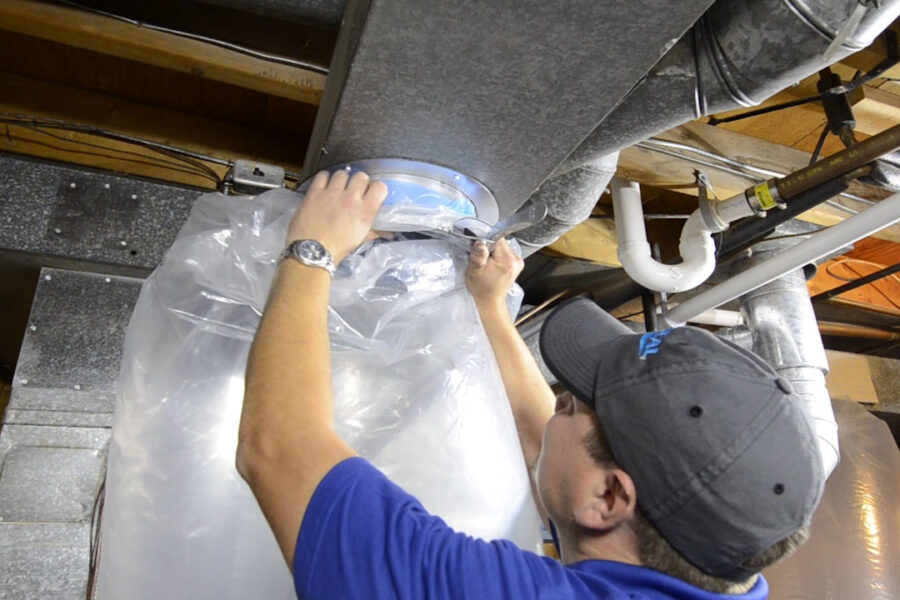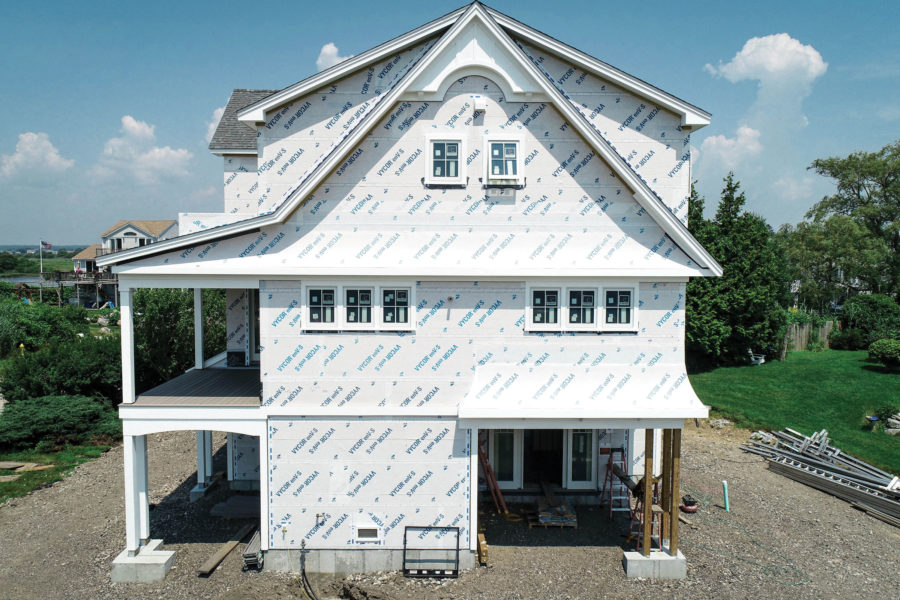Story at a glance:
- Eliminating volatile organic compound (VOC) sources is essential to good indoor air quality (IAQ).
- ASHRAE proposes a four-step plan to control VOC sources in buildings.
- Integrating only Red List-Free products in design and construction is crucial to limiting VOCs.
Poor indoor air quality is common in well-insulated, new buildings due to a large number of chemical contaminants known as volatile organic compounds (VOCs), according to the EPA. More designers and builders are looking to limit VOCs, demanding to know what’s in their building materials and choosing nontoxic alternatives instead.
In this article we consider strategies for identifying VOCs and how to select VOC-free building materials.
What are Volatile Organic Compounds?
VOCs are small, carbon-containing compounds derived from fossil fuels. They quickly go airborne at room temperature, becoming harmful air pollutants.
Outdoors, VOCs readily combine with nitrogen oxides in the presence of sunlight to form short-lived but harmful ground-level ozone—a constituent of smog and a potent greenhouse gas. Certain VOCs, like carcinogenic trichloroethylene and vinyl chloride, are highly mobile in groundwater and common drinking water contaminants.
Incidentally, methane, another powerful greenhouse gas, is technically a VOC. In this article we’re considering only non-methane VOCs that are primarily airborne.
Indoors, VOCs build up to toxic levels when they have no way to escape. High concentrations of VOCs and long exposure times are the two conditions that turn VOCs into health hazards for building occupants.
The most common airborne VOCs used to manufacture building materials and home furnishings include formaldehyde, benzene, toluene, xylene, ethylbenzene, tetrachloroethylene (perchloroethylene), and 1,3-butadiene (butadiene). Most of these chemicals are known or suspected carcinogens.
Strictly speaking, another commonly used chemical, methylene chloride (dichloromethane), is classified as a very volatile organic compound (VVOC). Pesticides and phthalates are called semi-volatile organic compounds. Chemicals are placed in various categories according to their boiling points and, to a lesser degree, their molecular weights.
Microbial VOCs (mVOCs) are another category of VOCs that may pose an indoor health risk. Usually produced by fungi or bacteria growing on damp building materials and moist HVAC surfaces or filters, certain mVOCs are associated with asthma.
Symptoms of Airborne VOC Exposure
The short-term symptoms of airborne VOC exposure include:
- Eye, nose, and throat irritation
- Chest tightness
- Dry coughing
- Shortness of breath
- Headaches
- Light-headedness
- Chills
- Muscle aches
- Dizziness
- Visual disturbances
- Brain fog
The long-term health consequences of airborne VOC exposure may be:
- Liver or kidney damage
- Central nervous system disorders
- Cancer
- Asthma
- Endocrine disruption
- Reproductive abnormalities
Volatile Organic Compound Sources in Building Materials
Here are a few of the most common VOC sources in products used as, in, or on building materials and furnishings:
- Pressed wood products
- Foam insulation
- Carpets
- Wallpaper
- Furniture
- Synthetic rubber
- Paints, paint removers
- Adhesives
- Wood preservatives
- Aerosol sprays
- Cleansers and disinfectants
How to Limit VOC Sources in Design

Photo courtesy of Aeroseal
Many strategies are available to designers and builders to limit VOC sources in projects.
ASHRAE published a useful guide of suggestions for limiting VOC source pollution in indoor air. Designers and architects may find ASHRAE’s Indoor Air Quality Guide: Best Practices for Design, Construction and Commissioning to be a source of inspiration for creating green buildings.
According to ASHRAE, the most important way of avoiding VOCs is to first eliminate their source. You can:
Select building materials, furnishings, and appliances with low or no VOC emissions.
Reduce indoor VOC sources by doing as much assembly of building materials as possible outside of the new build site, waiting until they off-gas before installing them.
Remove VOC sources from building materials by unwrapping and waiting until they have off-gassed before taking them on site. If temporarily housed indoors, air filtration and purification at that location will remove most of them.
Design, run, and upkeep buildings, HVAC, and plumbing to reduce the occurrence of moisture ingress, and correct problems immediately.
Building Materials with Low or No VOCs

Photo courtesy of GCP Applied Technologies
As green building and design enters the mainstream, more companies are offering no- or low-VOC building materials and furnishings. Here are a few.
Wood Products
A perfect example of a wood product that is unlikely to produce microbial VOCs is the thermally modified wood that’s heated at over 180℃ in an oxygen-free environment.
“It is this breaking up of the hydroxyl groups in the wood’s cellular structure that increases both durability and biological resistance by permanently reducing the material’s tendency to absorb water and serve as a food source for mold, rot, fungal decay, and insects,” John Heyesen, vice president of business development for Intectural—distributor of premium architectural materials and producer of Arbor Wood thermally modified timber—previously wrote for gb&dPRO.
Vapor Barrier
GCP’s PERM-A-BARRIER NPS is another building material that isn’t a source of VOCs. The non-permeable, primer-less, self-adhered air and vapor sheet membrane increases energy efficiency and reduces HVAC usage.
“Less HVAC use means significantly less energy use, less money spent on heating and cooling, and a more sustainable structure,” Marysusan Couturier, R&D director of post-applied/air barriers/residential/fireproofing at GCP Applied Technologies, told gb&d previously.
Paints
VOCs typically are incorporated as solvent in paints. In latex or water-based paints, water is the primary solvent, making this a good place to start when looking for nontoxic paint options. You can find a long list of nontoxic, low-VOC paints here.
Air Sealing
If you’ve done everything possible to eliminate VOC sources but the problem persists, ASHRAE’s next steps are to ventilate and purify the air.
Leaky ductwork reduces the amount of VOC-containing air that exits a building as well as lowers the quantity of filtered outside air that enters. Aeroseal solves both of these problems by sealing the leaks.
“After we pressurize the system we inject it with the aerosolized sealant—essentially a fog of sealant. That sealant finds all the little cracks and holes and fills them up,” Bob Swilik, vice president of product strategy at Aeroseal, previously told gb&d. “After we’re done we measure pressure and leakage again, the same way we did when we started, and we look at the difference between the starting and ending point. The difference is usually in the neighborhood of more than 90%.”
Red List-Free Products
Designers and builders who wish to eliminate volatile organic compound sources in the building materials they use may consider the International Living Future Institute’s Red List-Free products. Made without harmful chemicals, including VOCs, these materials are the most nontoxic ones on the market today.




